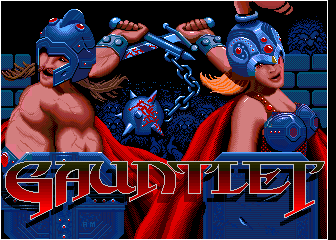
"Elf needs food... badly."
"Elf is about to die!"
If you heard these words coming from an arcade machine back in the mid to late 80s, you knew someone was about out of quarters. This warning told everyone around that another player was about to fall before the challenge of Gauntlet. An undisputed masterpiece, featuring digitized speech, four player co-op, and endlessreplayability, Gauntlet is the focus of this week's Co-Op Classics, along with its sequel, Gauntlet II.
During the early 1980s, the "swords and sorcery" genre absolutely exploded in all types of media. Conan the Barbarian was a blockbuster at the movies. Dungeons and Dragons became a household name, appearing in a much-loved Saturday morning cartoon as well as spawning countless rules books. It was no surprise then, that video games would follow suit. Gauntlet was certainly not the first fantasy video game, but it was the greatest in 1985, and arguably, is one of the best of all time.
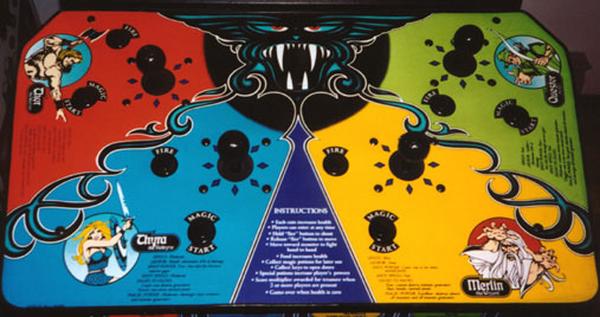
What set Gauntlet apart? For starters, the presentation was top notch. The cabinet was colorful and eye catching. The sideart took up a huge amount of real estate and the control panel was a thing of beauty. All four players and even a few observers could see the action easily since the monitor was mounted high. The graphics, though primitive by today's standards, were crisp and bright, and often the screen was literally packed with enemies. Plus, Gauntlet had digitized speech! That was uncommon for games of the time, and hearing "Save keys to open doors!" in attract mode was quite enticing. You would be hard pressed to find a more appealing arcade machine even now.
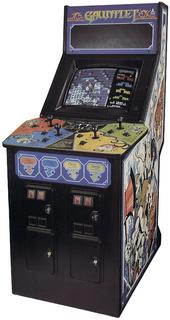
It was the gameplay, though, that took Gauntlet above and beyond its contemporaries. Cooperative gameplay, which we love so much here at Co-Optimus, was a huge draw. If you didn't work together with fellow players, you were dead, plain and simple. Additionally, the variety of the characters was impressive. In most multiplayer games, all the characters played the same, and were just palette swaps of each other. Not so for Gauntlet. Questor the elf darted around the screen, rapidly shooting off volleys of arrows. Merlin the wizard felt weak and old... until he wiped the screen out with a magic potion. Thor the warrior and Thyra the valkyrie could wade into hand to hand battle indiscriminately, wielding a wicked axe and a mighty sword to mow down hordes of ghosts or demons. Gauntlet's gameplay truly captured the feeling of tabletop Dungeons and Dragons, with each player feeling like part of a team, and working together; this was co-op at its finest.
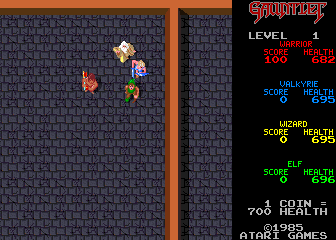
The mazes in Gauntlet were filled with hazards and rewards. Keys let you skip levels entirely, if you knew the right time to use them. Eating food refilled your ever dwindling health meter, and felt almost like finding a free quarter laying on the ground! Treasure added to your total score. Magic potions destroyed multiple enemies at the same time. All sorts of potions helped buff your characters attributes, such as weapon speed and magic power. But you had to fight hard for such a bounty! Ghosts and grunts appeared early, and eventually demons and sorcerers swarmed you. Lobbers were totally unfair, attacking over walls, and the thief would appear and steal your loot! Even Death itself would assault the party, draining health at an alarming rate until staved off by using magic.
Beyond the first few levels, the mazes were shuffled up each time you played. There were no patterns to memorize here, instead, a fresh experience was available each time you plunked in a coin. Given the ever changing level designs, and the different feel of each character, Gauntlet was a blast to play over and over again.
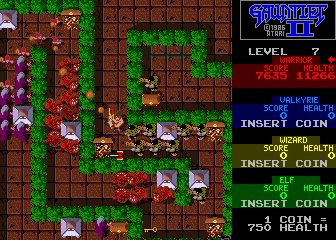
Gauntlet II appeared a year after the original, and made some refinements to the basic formula as well as adding new features. Players were no longer tied to character choice by joystick position; you could mix and match as you liked, even trying a party of four wizards, if you liked. Dozens of new levels were available, and new enemies appeared, such as a dragon that took up more than one square on the screen. Newpower ups and traps like the ricochet shot (an elf's best friend) and acidic puddles that did tremendous damage added to the experience. Gauntlet II took all the great things about the original, and cranked them all up a notch or two.
Gauntlet is a landmark game in co-op history. As one of the first four player arcade machines, it often was retooled and converted to newer games (Gauntlet II was a conversion kit, for example). I doubt that four player games would have been so popular later on were it not for Gauntlet's initial success. The phrases from the game are embedded into pop culture even today, more than two decades later. Gauntlet is available on XBLA, and Gauntlet II for PSN.
The co-op gameplay is obviously still popular, and Gauntlet has spawned some great remakes over the years. In 1998, Gauntlet Legends was released, bringing the elf, wizard, valkyrie and warrior to the third dimension. In 2000, Gauntlet Dark Legacy took the concept from Legends and expanded on it greatly, adding new classes and an epic, lengthy quest. Both games were ported to most home systems of the time. The co-op on these two titles carried on the fine tradition begun by Gauntlet itself. We will take an in depth look at both Gauntlet Legends and Gauntlet Dark Legacy in next week's Co-Op Classics. Until then, remember, don't shoot the food!
Thanks to the Killer List of Videogames for images!